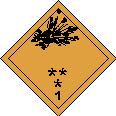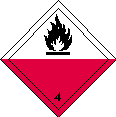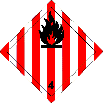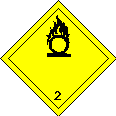Canadian TDG Labeling
03
February,
2023
3 MINUTE READ

The Canadian Transportation of Dangerous Goods (TDG) Act requires that containers holding dangerous materials be marked to show the nature of the danger. Dangerous materials are defined as any material that presents a danger to life, property or the environment under normal conditions of transport.
The TDG labeling provides quick identification of the container contents, and hazard class, in the event of an emergency or an accidental release. It also informs transportation and loading dock workers about the materials they are handling.
There are two types of markings used. In general, labels are used on small means of containment and placards are used on large means of containment. What does this mean?
TDG and Labeling - Types of Containment

A containment is the vessel, vehicle, or other container used to safely hold a dangerous material. The TDG Act divides containers into two categories:
- A "small means of containment" are containers that have a water capacity of less than 450 liters. These types of containers include drums, barrels, bulk containers, boxes, jerricans, bags, and cylinders.
- A "large means of containment" is a container with a water capacity that is greater than 450 liters. Containers that are consider to be a large means of containment include: tanker truck trailers, railroad tank cars, intermediate bulk containers, and large portable tanks.
All containers holding dangerous materials that are offered for transport, must be marked with a durable, visible, weather-resistant, and legible marking before the container is loaded for transport. In general, placards are used for large means of containment and labels are used for small means of containment.
TDG and Labeling - Small Means of Containment Labels

Part 4 of the TDG Act specifies the size, content, and design of TDG labels. The specifications include:
- Labels are diamond shape (square on a point).
- Each side of the TDG label must be at least 100 mm in length.
- There must be border consisting of a line located 5 mm inside the edge of the label.
- The size of the label may be reduced in order to fit smaller containers, provide that:
- the label size is not reduced below 30 mm. Tags may be attached to containers that are too small for a TDG label.
- if the TDG label size is reduced, the label contents (symbols, text and numbers) must be reduced in proportion.
- If a UN number is required, it must be displayed:
- next to the primary class TDG label
- within a white rectangle included in the primary class TDG label
- Colors used for TDG labels must be the following standard colors:

- Blue - Pantone 285
- Green - Pantone 335
- Orange - Pantone 151
- Red - Pantone 186
- Yellow - Pantone 109
TDG and Labeling - Required Labels
The TDG Act categorizes dangerous materials by class. The classes identify the type of hazard such as: explosive, flammable, toxic and infectious, oxidizing, radioactive, and corrosive. Some materials may be in multiple classes, in which case there will be a primary class. The primary class is the first class identified in TDG Schedule 1 column 3. The precedence used to identify the primary class is given in the TDG Act section 2.8.

On small means of containment there must be one TDG label for the primary class, and one TDG label for each subsidiary class. If the small means of containment is inside another small means of containment, only the outer container needs to be labeled. Labels may be placed on any side of the container, except the side on which the container rests (the bottom).
There is an exception to these requirements. Containers holding class 7 materials (these are radioactive materials) must be labeled on two opposite sides of the outer container. Labels may not be placed on the side on which the container rests (the bottom).
TDG and Labeling - Other Requirements
You should be familiar with the Canadian TDG labeling requirements before shipping or transporting dangerous materials. The above is only a short summary. There are other TDG labeling requirements that apply in various situations. For example, if flammable materials are being transported by ship, the flashpoint must be displayed on the label next to the shipping name of the dangerous material. Being in complete compliance with the TDG labeling requirements is not only required by law, it is important for the safety of the people handling and transporting the dangerous materials.
Ensure you're compliant with Canadian TDG and other international regulations with our introductory International GHS Labeling Guide which touches on common labeling standards for businesses expanding globally. Download your free copy below.
RELATED RESOURCES

BS5609 Compliance and GHS
BS5609 is the British Standard for pressure-sensitive adhesive labels used for marine applications. Also ...
Read
June 2016 GHS Timetable
With its publication in the Federal Register on March 26, 2012, OSHA's rewritten Hazard Communication ...
Read
GHS Purple Book
The GHS is described in a book, informally known as the "Purple Book." This book contains information on all ...
Read.png)


